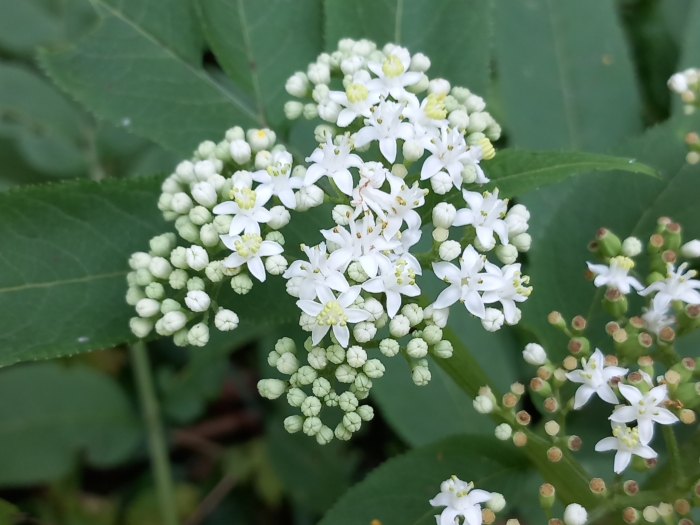Danewort
(Sambucus ebulus)
Danewort (Sambucus ebulus)
/
/

KAnatoliy
CC BY 4.0
Image By:
KAnatoliy
Recorded By:
Copyright:
CC BY 4.0
Copyright Notice:
Photo by: KAnatoliy | License Type: CC BY 4.0 | License URL: http://creativecommons.org/licenses/by/4.0/ | Rights Holder: KAnatoliy | Publisher: iNaturalist | Date Created: 2023-08-15T09:54:43-07:00 |


















Estimated Native Range
Summary
Sambucus ebulus, commonly known as danewort, dwarf elder, or European dwarf elder, is a herbaceous perennial native to a variety of habitats including open woodlands, grasslands, and along riverbanks in southern and central Europe, as well as southwest Asia. It has also become naturalized in some regions of North America. The plant typically grows 3-7 feet tall and features erect, unbranched stems emerging from an extensive underground rhizome system. The leaves are opposite, pinnate, with 5-9 leaflets, and are known to emit a foetid smell when crushed. Danewort blooms in late summer, producing clusters of small white flowers that are followed by black or dark purple berries.
Danewort is appreciated for its medicinal properties, as various parts of the plant have been used traditionally for their diuretic and anti-inflammatory effects. In gardens, it can serve as an informal hedge or a naturalistic border plant, though it should be used with caution due to its potential invasiveness. It prefers full sun to partial shade and grows best in well-drained soil, tolerating a range of soil types. While it is relatively low maintenance, it may require control to prevent it from spreading too aggressively.CC BY-SA 4.0
Danewort is appreciated for its medicinal properties, as various parts of the plant have been used traditionally for their diuretic and anti-inflammatory effects. In gardens, it can serve as an informal hedge or a naturalistic border plant, though it should be used with caution due to its potential invasiveness. It prefers full sun to partial shade and grows best in well-drained soil, tolerating a range of soil types. While it is relatively low maintenance, it may require control to prevent it from spreading too aggressively.CC BY-SA 4.0
Plant Description
- Plant Type: Herb, Shrub
- Height: 3-6 feet
- Width: 3-6 feet
- Growth Rate: Rapid
- Flower Color: White
- Flowering Season: Summer
- Leaf Retention: Deciduous
Growth Requirements
- Sun: Full Sun, Part Shade
- Water: Medium
- Drainage: Medium
Common Uses
Bee Garden, Butterfly Garden, Low Maintenance
Natural Habitat
Open woodlands, grasslands, and along riverbanks
Other Names
Common Names: Dwarf Elder, Dane Weed, Dwarf Elderberry, Elderwort, Blood Elder
Scientific Names: , Sambucus ebulus, Ebulum humile, Ebulus humile, Sambucus cochinchinensis, Sambucus deborensis, Sambucus ebulus f. laciniata, Sambucus ebulus f. xerophila, Sambucus ebulus subsp. laciniata, Sambucus ebulus var. citrina
GBIF Accepted Name: